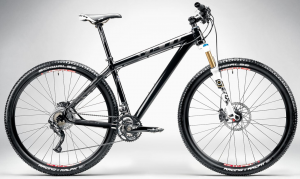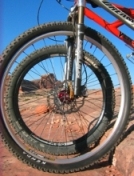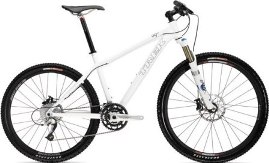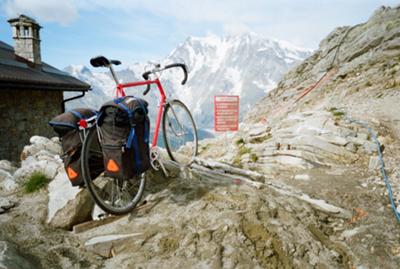29 Inch Mountain Bikes vs. 26 Inch Mountain Bikes

29 inch mountain bikes are not going to revolutionize mountain biking the way suspension forks did, however they do have their advantages and some people will swear by them.
 If you haven’t decided on a full suspension or hard-tail yet then click back to return to step 3
If you haven’t decided on a full suspension or hard-tail yet then click back to return to step 3
When it comes to choosing the right size mountain bike forget about the size of the frame or the length your crank length and saddle height. The first thing you need to decide is: are you a 26er or a 29er?
I am of course referring to the size of the wheels on your bike. Check out the picture below for a look at their difference…

The 29 inch mountain bike ride is different to a 26 incher and it’s good!
Riding with bigger wheels at lower pressures the wheels absorb small bumps and holes in the trail and stick to it like a fly on maple syrup. The downside? Weight! You will never be able to build wheels on 29er mountain bikes as light as 26 inch wheels. And that extra weight is rotating mass so it counts double.
A 29 inch mountain bike is actually very similar to long travel dual suspension trail bikes. Both have extra weight and slow steering and are designed for similar situations. So which is best? Read on to find out…
…both types of bikes are actually very good at trail riding. A long travel dual suspension 26” bike will take the 29er on rougher descents and descents with tight turns but you will find a 29er to be more stable and confident in technical situations. This is due to its rigid frame, wheels that easily roll over small obstacles and a lower centre of gravity. A dually on the other hand will hang-up on rocks, its suspension will absorb valuable momentum and it will generally lurch around.
So does the 29er win the contest because it can match the performance of a more expensive and advanced dually, or does tunable suspension make the 26er more versatile and the winner? Only you can answer that.
Why 29 inch mountain bikes?
One thing I can tell you is that big wheels found on 29 inch mountain bikes can be run at lower pressures and allow a bigger contact area with the ground. This gives much more grip. The extra weight and momentum they carry at speed will allow you to ride a straighter, more confident line.
They are however more suited to taller riders who find themselves getting bigger frame bikes.
If you are not the tall then it comes down to how you ride. But if you can’t afford a quality dual suspension trail bike I would seriously consider the smoother ride you can get from cheaper 29er mountain bikes.
Of course you can always go for the much more expensive and much heavier dual suspension 29 inch mountain bikes, but that’s another can of worms.
How do 29er Mountain Bikes Ride?
| Trail Type | 29er | 26er |
|---|---|---|
| Long, easy climb | Nice Rhythm | Very consistent |
| Singletrack | Heaps of fun | Even more fun |
| Switchback Climb | Confident Line | Wandered, dabbed and walked the end |
| Descent | Bumpy but good corner grip | Very smooth |
| Flat Flowing Singletrack | Felt quick but wasn’t | Smooth and fast |
| Technical Singletrack | Easily rolls over obstacles | Hung up at low speed but fast on descents |
| Whole Trail | Comfortable Ride | Felt like more work but quicker |
Anyone for a 69er?
No not that! A 69er bike.
A combination between a 26er and a 29er, a 69er has a 29” wheel up front and a 26” wheel down the back. A small amount of weight is saved and they accelerate a bit faster than full 29 inch mountain bikes but the big difference is with the chainstay.
A shorter chainstay brings the rear wheel in close to the bottom bracket. This helps climbing and shortens the overall wheel base. It also helps to get the front wheel up in times of need (over a log or just chucking a wheelie). Maintenance and spares for 2 different wheel sizes can make things a bit difficult though.

Want to Find Your Perfect Bike?
Want to buy a mountain bike? Then you must check out Your Essential Bike Buying Guide. It will take you step-by-step on the process of finding your perfect bike (and saving $$ in the process). Find out more.







